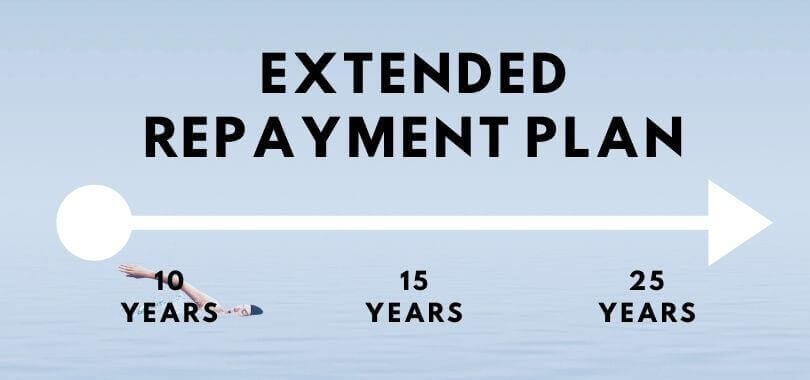The Federal government gives Federal student loan borrowers several different repayment options to make it easier for them to pay back their loans. One such option is the extended repayment plan. This plan allows borrowers to make lower payments every month by extending the tenure of the loan from the standard plan of 10 years to up to 25 years. The exact extension will depend on various factors.
If you need to lower your monthly payments over a longer period than your current repayment plan, the extended repayment plan may be for you. Before you make the switch, it helps to understand how the plan works, its pros and cons, and alternative plans that you can choose from.
How The Extended Repayment Plan Works
Federal student loans come with a standard repayment plan of 10 years. This divides the total amount owed (principle + interest accrued over 10 years) into 120 equal installments. The repayments kick in six months from the day you graduate. Starting from that date, you have to pay the same amount every month over the next 10 years.
If, at any time during the repayment period, you find that you cannot afford the monthly payments, you can switch your student loan repayment plan. Under these circumstances, the extended repayment plan could be a good alternative. This repayment plan stretches the repayment period over up to 25 years. This term extension instantly lowers your monthly payments making them more affordable.
The exact amount you pay every month will depend on whether you choose fixed or graduated payments. With fixed payments, your total amount owed is divided equally over the repayment period. With graduated payments, your monthly repayments start small to give you the chance to regroup your finances. The repayments increase incrementally over the years, with the final installment coming due within the 25-year maximum.
Which Federal Loans Are Eligible For The Extended Repayment Plan
Not all federal loans are eligible for the extended repayment plan. These loans from the Direct Loan Program and Federal Family Education Loan (FFEL) Program are eligible:
- Direct Subsidized Loans
- Direct Unsubsidized Loans
- Direct PLUS Loans
- Direct Consolidation Loans
- Subsidized Federal Stafford Loans
- Unsubsidized Federal Stafford Loans
- FFEL PLUS Loans
- FFEL Consolidation Loans
Perkins loans are not eligible for extended repayment but there is a way around this by consolidating your Perkins loans into a Direct consolidation loan.

Eligibility for the Extended Repayment Plan
In addition to having the right types of loans, there are a couple of other criteria you need to meet to qualify for the extended repayment plan.
- If you’re a Direct Loan borrower, you must have more than $30,000 in outstanding Direct Loans.
- If you’re an FFEL borrower, you must have more than $30,000 outstanding in FFEL loans.
If you have both types of loans and only one has $30,000 outstanding, only that loan will be eligible for the extended repayment plan.
Advantages Of The Extended Repayment Plan
- Makes payments more manageable: This plan reduces your financial burden by lowering the monthly payments. With lower monthly payments, you also reduce the risk of late payments and default.
- Protects your credit: Payment history has the largest impact on your credit score, accounting for 35% of the total. Missing loan payments can damage your credit score. The lower, more affordable monthly payments can help you stay on top of your loan dues and protect your credit history.
- It’s available for most types of loans: Almost all types of federal loans, including Direct, FFEL and PLUS loans are eligible for the extended repayment plan.
Downsides Of The Extended Repayment Plan
- Increases the cost of the loan: While extending the loan from 10 years to a possible 25 years may offer you a possible lifeline, the downside is that the interest on the loan keeps accruing throughout the extended period. This increases the total amount of the loan.
- Loan forgiveness is not available: Extended repayment plans do not qualify for PSLF. If you owe $72,000, you have to repay that full amount plus interest.
- Has a minimum amount requirement: You need to have more than $3,000 in one type of loan to qualify for the extended plan. If the need to lower monthly payments arises when you have $2,900 outstanding, you won’t be eligible to enroll in this plan.
Is The Extended Repayment Plan Right For Your Student Loans?
There’s no single answer that’s right for everyone. Whether or not the extended repayment plan is the right choice for your student loans depends on your unique situation.
Lowering the monthly payments can make your budget more flexible, leaving room to handle your other financial responsibilities. It also helps protect and even build your credit score slowly and steadily and minimizes the risk of delay and default. While the relaxed timeline can solve your short-term financial struggles, it could come at a cost. So make sure you explore your different repayment options before you make your final decision.
Looking for another way to make your repayments more affordable? Consider refinancing. Compare rates and refinance lenders side by side for FREE.






